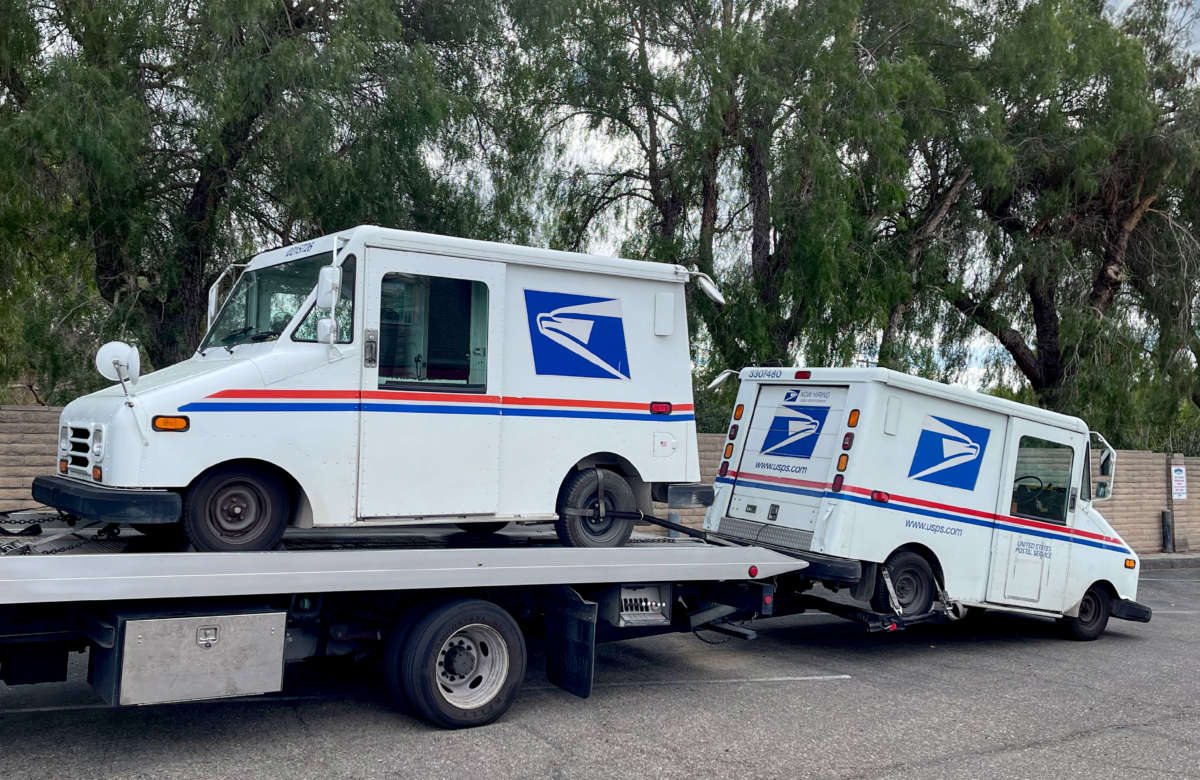Honest, paywall-free news is rare. Please support our boldly independent journalism with a donation of any size.
On Wednesday, the United States Postal Service announced that it has finalized its plan to replace its vehicles with a fleet comprised largely of gas-powered vehicles, a move that has enraged climate advocates and that defies President Joe Biden’s promise to electrify the agency’s fleet.
Under the direction of Postmaster Louis DeJoy, the agency is purchasing up to 148,000 gas vehicles, despite requests from the White House Council on Environmental Quality and the Environmental Protection Agency (EPA) to do otherwise.
The purchase would undermine climate plans from Biden, who had pledged to fully electrify the agency’s vehicles as the current fleet is long past its prime. USPS trucks make up about one-third of vehicles owned by the federal government.
The agency argues that a largely gas-powered fleet would be cheaper than buying an all-electric fleet. But although this may be cheaper up front, gas vehicles would likely cost more in the long term; the EPA contends that the agency has been using completely inaccurate gas price estimates in their analysis. The USPS also had a chance in making the plan to buy lighter trucks that are more fuel efficient, but it opted to buy trucks that are nearly double the weight of the current vehicles. Of course, this decision will actively advance the climate crisis and the U.S.’s dependence on fossil fuels.
Wednesday’s decision frustrated climate advocates. “DeJoy’s plans for the postal fleet will drag us back decades with a truck model that gets laughable fuel economy. We may as well deliver the mail with hummers,” Adrian Martinez, attorney for Earthjustice, said in a statement. “DeJoy’s environmental review is rickety, founded on suspect calculations, and fails to meet the standards of the law.”
Martinez added that Earthjustice is prepared to fight the decision in courts, saying that electrifying the fleet entirely would avoid the burning of 110 million gallons of fuel annually. Other environmental groups are poised to do the same.
Climate advocates say that the new fleet would needlessly lock in emissions for decades to come. Gas-powered mail trucks are especially inefficient energy-wise; according to the EPA, new gas trucks would get only 8.6 miles to the gallon, which is hardly an improvement over the current fleet’s average of 8.2 miles per gallon.
Over the trucks’ 20-year life expectancy, the EPA wrote in a letter to the Postal Service, a 90 percent gas-powered fleet would emit as much carbon dioxide as 4.3 million passenger vehicles, or five coal power plants. They would end up costing climate damages of $900 million, according to social carbon cost analysis.
Climate advocates say that electrifying the USPS fleet is “low-hanging fruit.”
“It seems like a no-brainer to be using electric trucks for this sort of thing, like mail delivery,” Zeke Hausfather, climate scientist and director of climate and energy for the Breakthrough Institute, told Truthout. “And it’s a real shame that in a time when climate change is such an important issue, and our leaders like the Biden administration are stating that it’s such an important issue, we’re on the cusp of locking in two or more decades of gas guzzling vehicles, that, to be honest, are only marginally more efficient than the trucks that the Postal Service bought 20 years ago.”
Electrifying the fleet is technically feasible for the agency – most mail routes are only 20 miles on average, which is well within the mileage that an electric mail truck could get with a smaller, cheaper battery. In 2009, when electric vehicle technology was less advanced than it is now, the Postal Service found that 96 percent of routes were compatible with electric trucks.
The trucks wouldn’t create harmful emissions while they idle as postal workers make their deliveries, and their constant stopping and restarting is inefficient for gas vehicles. Further, the trucks park in the same hub every night, meaning that it would be easy to ensure that they’re all charged for the next day.
While the U.S. is making progress toward Biden’s goal of cutting emissions in half by 2030, transportation is a crucial sector to decarbonize.
“To have any chance of meeting the Biden administration’s goal of a 50 percent reduction by 2030, we really need to meaningfully cut emissions from transportation. And the Postal Service is a pretty big emitter,” said Hausfather. Buying an all-electric fleet would not only cause a direct emissions reduction, but could also make it easier for other companies like FedEx or UPS to make similar purchases.
Wednesday’s announcement sparked calls, yet again, for DeJoy to be removed from his post. “Louis DeJoy is destroying the USPS. And now he’s tied the fleet to gas-powered trucks for 30 years, when we should be going electric,” said Sen. Jeff Merkley (D-Oregon). “Louis DeJoy should be fired.”
The embattled Donald Trump-era postmaster general has come under fire for his recently-implemented 10-year plan for the agency that is slated to slow delivery while raising prices. But DeJoy can only be removed by the Postal Board, which currently lacks the votes to replace him; Biden nominated enough Democrats to oust DeJoy last April, but his nominations are stuck in the Senate.
Press freedom is under attack
As Trump cracks down on political speech, independent media is increasingly necessary.
Truthout produces reporting you won’t see in the mainstream: journalism from the frontlines of global conflict, interviews with grassroots movement leaders, high-quality legal analysis and more.
Our work is possible thanks to reader support. Help Truthout catalyze change and social justice — make a tax-deductible monthly or one-time donation today.
